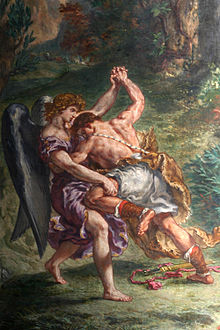Patriarchs (Bible)
족장설화(族長說話, 히브리어: אבות)는 타나크의 창세기에 나오는 족장들의 이야기를 말한다. 좁게는 아브라함, 이사악, 야곱, 요셉과 그 아들들의 이야기만을 가리키지만, 넓게는 아담부터 아브라함 사이의 이야기를 말한다. 야곱의 아들이자 고대 이집트의 총리였다는 요셉의 이야기인 요셉설화는 토마스 만의 소설 《요셉과 그의 형제들》의 소재가 되기도 했다.
The patriarchs (Hebrew: אבות Avot, singular Hebrew: אב Av) of the Bible, when narrowly defined, are Abraham, his son Isaac, and Isaac's son Jacob, also named Israel, the ancestor of the Israelites. These three figures are referred to collectively as the patriarchs, and the period in which they lived is known as the patriarchal age.
Judaism, Christianity, and Islam hold that the patriarchs, along with their primary wives, known as the matriarchs (Sarah, Rebekah and Leah) are entombed at the Cave of the Patriarchs, a site held holy by the three religions. Rachel, Jacob's other wife, is said to be buried separately at what is known as Rachel's Tomb, near Bethlehem, at the site where she is believed to have died in childbirth.
More widely, the term patriarchs can be used to refer to the twenty male ancestor-figures between Adam and Abraham. The first ten of these are called the antediluvian patriarchs, because they came before the Flood.
Definition[edit]
The patriarchs of the Bible, when narrowly defined, are Abraham, his son Isaac, and Isaac's son Jacob, also named Israel, the ancestor of the Israelites. These three figures are referred to collectively as the patriarchs, and the period in which they lived is known as the patriarchal age. They play significant roles in Hebrew scripture during and following their lifetimes. They are used as a significant marker by God in revelations[1] and promises,[2] and continue to play important roles in the Abrahamic faiths. Judaism, Christianity and Islam hold that the patriarchs, along with their primary wives, known as the matriarchs – Sarah (wife of Abraham), Rebekah (wife of Isaac) and Leah (one of the wives of Jacob) – are entombed at the Cave of Machpelah in Hebron, a site held holy by the three religions. Rachel is said to be buried separately at what is known as Rachel's Tomb, near Bethlehem, at the site where she is believed to have died in childbirth.[3]
More widely, the term patriarchs can be used to refer to the twenty male ancestor-figures between Adam and Abraham. The first ten of these are called the antediluvian patriarchs, because they came before the Flood.
Lifespans[edit]
The lifetimes given for the patriarchs in the Masoretic Text of the Book of Genesis are: Adam 930 years, Seth 912, Enos 905, Kenan 910, Mahalalel 895, Jared 962, Enoch 365 (did not die, but was taken away by God), Methuselah 969, Lamech 777, Noah 950.[4] The lifespans given have surprising chronological implications, as the following quotation shows.

Explanation of color-codes:
- Lifespans recorded in the Septuagint: Black (▄▄) and gray (▄▄)[note 1]
- Lifespans recorded in the Syriac Peshitta: Gold (▄▄), yellow (▄▄), and brown (▄▄)
- Lifespans recorded in the Masoretic text: Crimson (▄▄), vermilion (▄▄), and cinnabar (▄▄)
- ^ Methuselah survived the flood according to the Septuagint (but not the Masoretic text or Syriac Peshitta), even though he was not on Noah's Ark.[6]
Matriarchs[edit]
The matriarchs, also known as "the four mothers" (ארבע האמהות), are:[7]
- Sarah, the wife of Abraham
- Rebekah, the wife of Isaac
- Leah and Rachel, the wives of Jacob
- Secondary matriarchs — Some Jewish sources list Bilhah and Zilpah (Jacob's concubines) as additional matriarchs, for a total of six matriarchs.[8][9] Other sources also include an emphasis on Tamar (the daughter-in-law of Judah) and Asenath (Osnat) (the wife of Joseph).[10]




